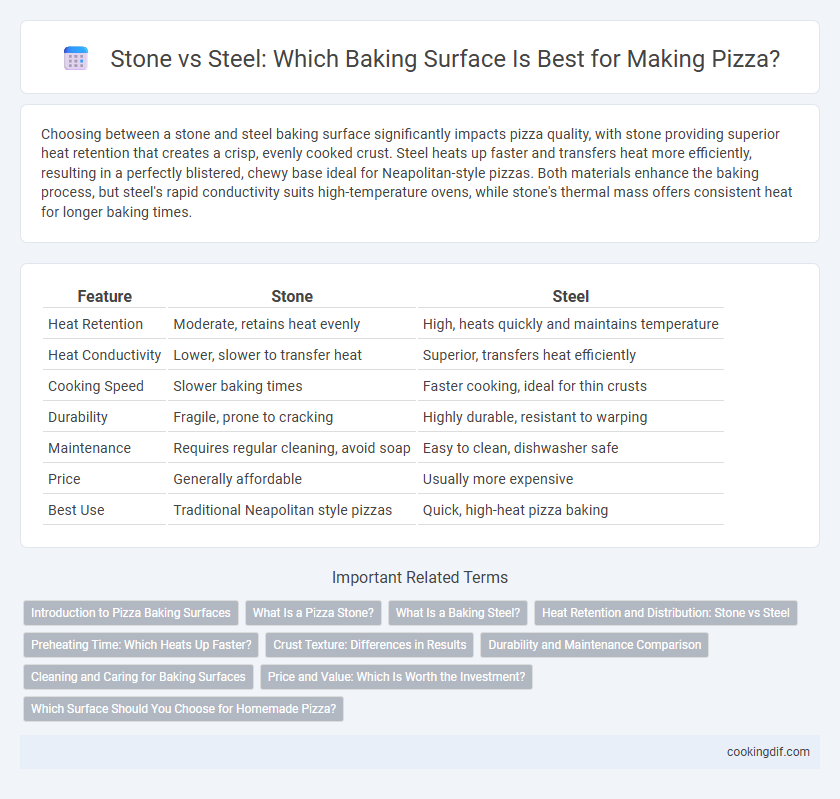Choosing between a stone and steel baking surface significantly impacts pizza quality, with stone providing superior heat retention that creates a crisp, evenly cooked crust. Steel heats up faster and transfers heat more efficiently, resulting in a perfectly blistered, chewy base ideal for Neapolitan-style pizzas. Both materials enhance the baking process, but steel's rapid conductivity suits high-temperature ovens, while stone's thermal mass offers consistent heat for longer baking times.
Table of Comparison
| Feature | Stone | Steel |
|---|---|---|
| Heat Retention | Moderate, retains heat evenly | High, heats quickly and maintains temperature |
| Heat Conductivity | Lower, slower to transfer heat | Superior, transfers heat efficiently |
| Cooking Speed | Slower baking times | Faster cooking, ideal for thin crusts |
| Durability | Fragile, prone to cracking | Highly durable, resistant to warping |
| Maintenance | Requires regular cleaning, avoid soap | Easy to clean, dishwasher safe |
| Price | Generally affordable | Usually more expensive |
| Best Use | Traditional Neapolitan style pizzas | Quick, high-heat pizza baking |
Introduction to Pizza Baking Surfaces
Stone and steel are popular baking surfaces that significantly impact pizza crust texture and cooking time. Pizza stones, typically made of ceramic or cordierite, retain heat evenly and absorb moisture for a crispier crust, while steel surfaces conduct heat faster, allowing for quicker baking and a chewier texture. Choosing between stone and steel depends on whether you prioritize traditional, high-heat baking or efficiency and durability in your pizza-making process.
What Is a Pizza Stone?
A pizza stone is a natural ceramic or cordierite slab used to replicate the heat retention and even cooking of a traditional pizza oven, absorbing moisture to create a crisp crust. Stone surfaces provide superior heat distribution but can crack under thermal shock, whereas steels offer faster heat transfer and greater durability. Choosing between stone and steel depends on desired cooking speed, durability, and crust texture for optimal pizza baking performance.
What Is a Baking Steel?
A baking steel is a thick, high-quality steel slab designed to retain and evenly distribute heat, making it an ideal surface for baking pizza with a perfectly crispy crust. Unlike stone, steel absorbs heat faster and transfers it more efficiently to the pizza dough, resulting in shorter baking times and improved caramelization. Professional and home bakers prefer baking steels for their durability, rapid heat retention, and enhanced ability to mimic the effects of a commercial pizza oven.
Heat Retention and Distribution: Stone vs Steel
Steel baking surfaces offer superior heat retention and faster heat transfer compared to stone, resulting in crispier pizza crusts and shorter baking times. Stone provides more even heat distribution, which helps prevent hot spots and ensures a uniformly cooked pizza. Choosing steel benefits high-temperature, quick baking, while stone excels in consistent, gentle heat for traditional, evenly baked pizzas.
Preheating Time: Which Heats Up Faster?
Steel baking surfaces heat up significantly faster than stone, often reaching optimal temperatures within 30 minutes compared to stone's 45 to 60 minutes. The higher thermal conductivity of steel allows it to absorb and transfer heat more efficiently, resulting in quicker preheating. This advantage makes steel ideal for home ovens aiming for rapid pizza baking without long waiting periods.
Crust Texture: Differences in Results
Stone baking surfaces absorb and retain heat evenly, producing a crisp, slightly chewy crust with characteristic air pockets due to consistent thermal distribution. Steel surfaces conduct heat faster, resulting in a sharper crust and quicker bake times that can mimic professional pizzeria ovens but may risk uneven charring if not monitored. Home bakers seeking a balance often prefer steel for rapid heat transfer and stone for traditional, artisanal crust textures.
Durability and Maintenance Comparison
Stone baking surfaces offer excellent heat retention but are more prone to cracking and require careful curing and cleaning to prevent damage, making maintenance higher. Steel surfaces exhibit superior durability with resistance to cracking and warping, and they demand less maintenance since they can be seasoned to create a naturally non-stick surface. For longevity and ease of upkeep, steel is often preferred by serious home bakers and professionals seeking consistent performance.
Cleaning and Caring for Baking Surfaces
Stone baking surfaces require careful cleaning by avoiding soap to prevent absorption of flavors, using a stiff brush or scraper to remove food residue, and ensuring thorough drying to prevent cracking. Steel baking surfaces are easier to clean with warm water and mild detergent, resist cracking, and demand regular seasoning to maintain a non-stick surface and prevent rust. Proper care of both materials extends their lifespan and improves baking performance by maintaining consistent heat conduction.
Price and Value: Which Is Worth the Investment?
Stone baking surfaces typically cost between $20 and $50, offering excellent heat retention for crispy crusts at an affordable price, making them a popular choice for home pizza enthusiasts. Steel baking surfaces, priced around $70 to $150 or more, provide superior heat conductivity, resulting in faster cooking times and evenly browned pizzas, representing a higher upfront investment with enhanced performance. The value of each depends on cooking frequency and budget; stones deliver reliable results at lower costs, while steel offers durability and professional-quality baking for serious pizza makers willing to invest more.
Which Surface Should You Choose for Homemade Pizza?
Stone surfaces retain heat evenly, producing a crispy, well-cooked pizza crust by absorbing moisture during baking. Steel surfaces heat up faster and transfer superior heat conductivity, ensuring quicker cooking times and a perfectly charred crust. Choose stone for traditional texture and warmth or steel for speed and crispiness in homemade pizza baking.
Stone vs steel for baking surface Infographic

 cookingdif.com
cookingdif.com